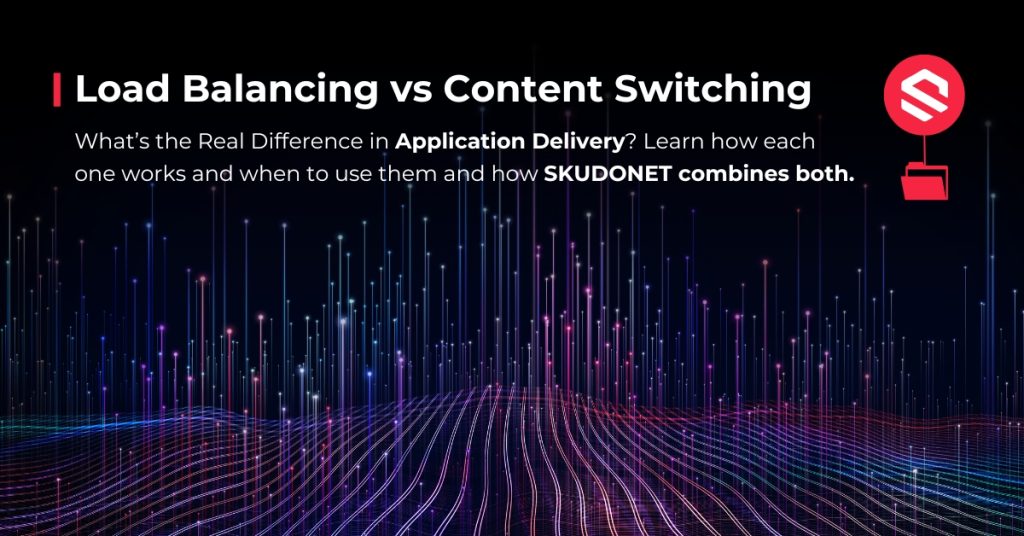When managing application traffic, two concepts often come up: load balancing and content switching. While they may seem similar at first glance — both involve deciding how traffic should be handled — they serve distinct purposes and operate at different levels of the network stack.
Understanding the difference between them is key to designing a resilient, scalable, and efficient infrastructure. In this article, we’ll explore what each concept means, how they complement each other, and why both are essential in a modern Application Delivery Controller (ADC).
Contents
Load Balancing: Distributing Traffic for Performance and Availability
Load balancing is the foundation of any high-availability system. Its main purpose is to distribute incoming traffic across multiple servers so that no single resource becomes a bottleneck. This improves overall performance, ensures service continuity during spikes, and protects against the failure of individual components.
A load balancer makes routing decisions based on various criteria, depending on the layer of the OSI model where it operates. At Layer 4, it looks at IP addresses, ports, and protocols (like TCP or UDP) to direct traffic. This method is extremely efficient and fast, making it suitable for high-throughput environments where performance is critical.
More advanced scenarios use Layer 7 load balancing, where decisions are based on application-level data — such as HTTP headers, cookies, or even request payloads. This allows for smarter, more granular routing, but typically requires deeper packet inspection and more processing power.
Load balancing helps:
- Prevent server overload
- Maintain consistent response times
- Enable horizontal scalability
- Improve fault tolerance
In essence, it ensures that your infrastructure can grow and absorb traffic seamlessly — without downtime or degradation in user experience.
Content Switching: Routing Based on What’s Inside the Request
While load balancing decides which server should handle a request, content switching decides how that request should be handled — often by inspecting what’s inside it.
Content switching operates at Layer 7 and routes requests based on specific attributes of the traffic. For example, it can examine the HTTP host, path, query parameters, or headers to decide which backend pool or application should receive the request.
This is especially useful in multi-application or multi-tenant environments, where different services share the same infrastructure but must be routed differently based on content.
Let’s look at a few common scenarios:
- A request to www.example.com/api/ is sent to a backend optimized for API responses.
- A request with the header User-Agent: Googlebot is routed to a caching layer.
- Requests containing a specific cookie are redirected to a personalized experience service.
Unlike simple load balancing, content switching introduces business logic into the routing layer. It allows infrastructure to behave dynamically and serve content more intelligently — adapting to context, user profiles, or application states.
Load Balancing and Content Switching: Complementary, Not Competing
It’s not a matter of choosing between load balancing and content switching. In fact, they often work together as part of a complete traffic management strategy.
A typical flow in an ADC might look like this:
- At Layer 4, the ADC receives the connection and determines which virtual service it belongs to based on IP and port.
- At Layer 7, once the request is decoded, the ADC inspects the content and applies routing logic based on the headers, paths, or cookies.
- The request is then routed to the appropriate backend — which may itself be part of a load-balanced pool.
This layered approach allows organizations to gain both efficiency and control. Basic traffic is routed quickly with minimal latency, while more complex requests benefit from precise logic that enhances security and user experience.
How SKUDONET Handles Load Balancing and Content Switching
SKUDONET integrates both capabilities natively, allowing teams to define traffic behavior with precision and confidence — without sacrificing performance.
- Advanced L4 and L7 load balancing ensures that traffic is distributed intelligently and efficiently, with support for TCP, UDP, and HTTP/S protocols.
- Content switching rules can be defined through a graphical interface or config files, using conditions like paths, headers, cookies, or SNI to route requests.
- Traffic can also be filtered or blocked based on content — not just routed — enhancing the security layer of your infrastructure.
- SKUDONET supports API and rule templating, making it easier to apply logic consistently across services or environments.
In practice, this means you can:
- Serve multiple applications under a single public IP
- Route API calls and web requests to different environments
- Redirect based on geolocation, authentication status, or user type
- Protect resources through advanced filtering before traffic reaches your application
And because SKUDONET handles both L4 and L7 inspection, it can perform an initial filter of traffic (like blocking malicious bots) at the transport level — even before deeper analysis is applied. This layered defense makes the platform both faster and more secure.
The distinction between load balancing and content switching is not just academic — it has real-world implications for how your services perform, scale, and stay secure.
- Load balancing is about efficiency and resilience.
- Content switching is about precision and control.
Modern ADCs like SKUDONET combine both, allowing organizations to manage application traffic with clarity, flexibility, and confidence. Try
SKUDONET Enterprise Edition for 30 days and experience how intelligent traffic management works in real conditions.


